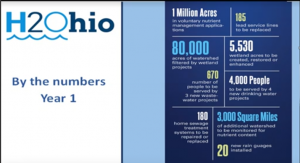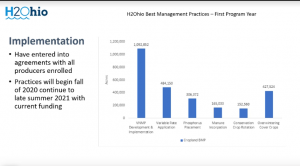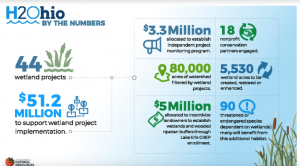Conservation, Homepage Slider, Water Quality
H2Ohio, Looking Back and Looking Ahead
By Dusty Sonnenberg, CCA, Ohio Field Leader: a project of the Ohio Soybean Council and soybean checkoff.
In spite of a global pandemic during a majority of 2021, nearly 1.2 million acres of farmland have been enrolled in voluntary nutrient management plans by close to 2000 producers in Northwest Ohio, along with several other Best Management Practices (BMP’s), as a part of the H2Ohio program. This was all done in a 14-county area, in an effort to improve water quality in Lake Erie, and represents 43% of the total cropland in those counties.
“H2Ohio is Governor Mike DeWine and Lt. Gov. John Husted’s policy initiative for investing in clean and safe water for Ohio,” said Joy Mulinex, Executive Director of the Lake Erie Commission. “It is a statewide initiative that addresses multiple clean water challenges.”  H2Ohio funds were spread across three agencies, including the Ohio Environmental Protection Agency (OEPA), the Ohio Department of Natural Resources (ODNR), and the Ohio Department of Agriculture (ODA), to address issues specific to their areas of oversight. “We have made a lot of progress in agricultural BMP’s, wetlands restoration, and infrastructure investments,” said Mulinex. “Under the Great Lakes Water Quality Agreement, Ohio is committed to reducing our total phosphorus (P) and dissolved reactive phosphorus (DRP), by 40%.”
H2Ohio funds were spread across three agencies, including the Ohio Environmental Protection Agency (OEPA), the Ohio Department of Natural Resources (ODNR), and the Ohio Department of Agriculture (ODA), to address issues specific to their areas of oversight. “We have made a lot of progress in agricultural BMP’s, wetlands restoration, and infrastructure investments,” said Mulinex. “Under the Great Lakes Water Quality Agreement, Ohio is committed to reducing our total phosphorus (P) and dissolved reactive phosphorus (DRP), by 40%.”
“Monitoring water quality at the Waterville gauge in the Maumee River has data going back to 1990. It shows that we are beginning to see a downward trend in the amount of Dissolved Reactive Phosphorus entering Lake Erie from the Maumee River. The total phosphorus has remained relatively constant during the past 30 years,” said Mulinex.
The ODA spent several months looking at the science and data in water quality, and selected seven out of ten BMP’s to promote to farmers for implementation in an effort to improve water quality. “The basis of these practices is a nutrient management plan,” said ODA Director Dorothy Pelanda. “Our objective is to improve water quality in the Western Lake Erie Basin through implementation of these strategic conservation practices.”
“The basis of these practices is a nutrient management plan,” said ODA Director Dorothy Pelanda. “Our objective is to improve water quality in the Western Lake Erie Basin through implementation of these strategic conservation practices.”
Implementation of BMP’s by farmers began this fall and will continue into the summer of 2021 with the current funding in place for year one. “The funding that we have is $30 million from H2Ohio and an additional $20 million provided by SB229 for the first year,” said Pelanda. “Because we have a known population that has signed contracts, we know how much funding we will need for future years. Full funding is needed to reach the target of a 40% P reduction by 2025.” The state 2022-23 biannual budget is still in the works. “Our goal in this next year is to add an additional 10 counties in the Lake Erie Region, starting with Nutrient Management Plans,” said Pelanda. “The ODA has the funding to continue these practices in the original 14 counties.”
The focus of the ODNR has been on Natural Infrastructure and the development of Wetlands. The ODNR has invested over $50 million in 44 wetlands projects in the past year. “Wetlands are one of the most effective and cost-efficient long-term solutions to reducing excess nutrients in our waterways,” said Mary Mertz, Director of the Ohio Department of Natural Resources.
The ODNR is working with the Lake Erie CREP as a part of the H2Ohio Water Quality Incentive Program. “This program offers a one-time payment of $2,000 per acre in combination with Lake Erie CREP to restore wetlands and forested buffers,” said Mertz. “Up to $5 million has been allocated. Wetlands and riparian buffers reduce nutrient loading into waterways and help reduce flooding. Riparian buffers also stabilize streambanks and reduce soil erosion.”
The ODNR has allocated $3.34 million to establish an independent project monitoring program. An estimated 80,000 acres of watersheds are filtered by wetland projects. There are 5,530 acres of wetlands that are planned to be created, restored or enhanced.
The Ohio EPA has invested $3,500,000 for six critical water and sewer projects. Three were wastewater projects in Miami, Meigs and Williams Counties serving 600 people and 250 homes.
Three were drinking water projects in Pike, Coshocton, and Columbiana counties serving 4,000 people in rural Ohio. An additional $1,250,000 was invested in lead service line and fixture replacements for safe water at Ohio daycare facilities. Seven local health districts received at total of $1,750,000 for the replacement of household sewage treatment systems. “The EPA has installed an additional 20 collection gages across the state to improve weather forecasting and rainfall estimates in Northwest Ohio,” said Lori Stevenson, Director of the Ohio EPA. “The goal is to increase our monitoring and data collection of rainfall, nutrients and pollutants.”
The complete 2020 H2Ohio Annual report is available for review and to download on the ODA website.